Read
Putting Your Marketing Data to Work
how to unlock the full potential of your AI and marketing strategies

In the last post of our AI Empowered series, we discussed how marketers can learn and utilize AI in their workflows. But keep this in mind before you start: AI isn't just intelligent; it uses data to solve problems and answer questions successfully. A critical step to maximizing your AI opportunities is employing a strategic approach to your organization's data. Here's how to begin.
starting your data journey
strategic alignment of AI goals
Ensure your organization's AI initiatives align with broader business and marketing objectives and set measurable goals to improve patient experiences and contribute to organizational growth. If you followed the steps we outlined in our last post, your team should have a solid understanding of AI essentials, and your AI initiatives should already be where they need to be.
begin data exploration
With company goals in mind, you now have a better understanding of what you want to do with data—so now it's time to actually look at it. Conduct a comprehensive data audit encompassing patient demographics, behaviors, preferences, payer mix, and geographical information, and identify data sources, including CRM systems, marketing platforms, and sales databases. It's important to remember that at this stage, the goal is not to use the data but to understand what you have and its potential applications in marketing strategies.
consolidate data
ensure data quality and governance
As AI advances, maintaining high-quality, clean data becomes paramount. Before and after introducing the data to AI, walk through the data sets to ensure they are complete, accurate, and consistent. Any "off" data can cause your AI to produce incorrect results, becoming a problem rather than a helpful resource.
Once insufficient data has been flagged, decide whether to remove, replace, or estimate missing values, delete duplicate records, and fix any errors or inconsistencies. Establish data governance policies to ensure accuracy, privacy, and security, and check in on the data quarterly to ensure accuracy.
centralize disparate data sources
With data cleaned and sources secured, everything—marketing lead data, patient records, and financial/payer information—should be centralized somewhere easy to access. Many hospitals use data warehouses, which store clean and processed data, while data lakes retain raw data.
Even if you choose not to use a data warehouse or lake, data should still have some structure, such as in a database or spreadsheet. Choose the right option for your health system, and then you can start reaping the benefits. A centralized approach enhances data security and enables AI to refine reporting on marketing performance and inform more targeted campaigns.
proceed with AI integration
identify opportunities for improvement
Use the insights gathered from your data audit to pinpoint areas where AI can make the most impact, such as personalizing patient communications or optimizing marketing spend. Be sure to include the team in the brainstorming sessions, as they may have solid suggestions.
experiment and learn
Put AI to the test with small projects that show value and allow for learning—this may include analyzing patient feedback or customer segmentation. Use these projects as benchmarks for broader AI integration in marketing strategies. Don’t be afraid to experiment and see how AI does with larger projects, like content suggestions or risk predictions.
continue unlocking the future
AI and data are the future of the healthcare industry, and more health systems are beginning to invest in data warehouses and API integrations. Keep your hospital ahead of the curve with our AI Empowered guidebook, which dives into the power of AI in healthcare marketing.

